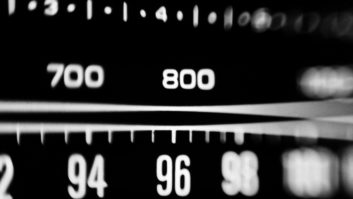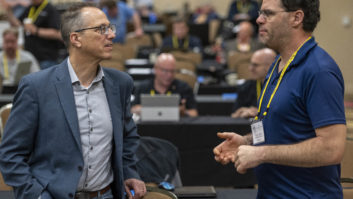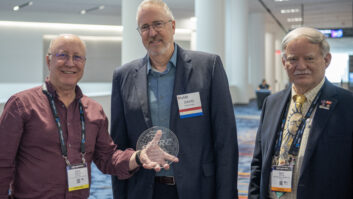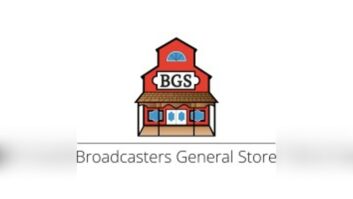I spoke via e-mail recently with David H. Layer, the senior director of advanced engineering at the National Association of Broadcasters, about what he viewed as the most important developments seen at the NAB Show this spring. Our discussion was in prep for Radio World’s Web seminar “25 Things You Might Have Missed at NAB,” which we presented for the second year.
The Webinar is quite a research project, and the result is an informative, interesting hour of content. It’s good stuff, whether you made it to the convention or, especially, if you didn’t. You can watch it for free right now; just register at radioworld.com. Thanks to our sponsors Telos/Omnia/Axia, Logitek and Digigram for making it possible.
PM: What was the most important technology trend or event you observed at the NAB Show of relevance to radio engineers and managers?

David Layer says integrating the FM antenna into the cell phone opens exciting possibilities. This is a slide from our ‘25 Things You Might Have Missed at NAB’ Webinar. You can watch it for free online. DL: The emergence of cell phones with integrated FM antennas is a very exciting and important development. NAB was publicizing this breakthrough in the “Radio Heard Here” booth and gave away Motorola ROKR EM35 GSM cell phones to four lucky attendees (one each day the exhibit hall was open; these can be used with either AT&T or T-Mobile) which includes an FM radio and integrated FM antenna. This is significant because for the first time, radio listening over a cell phone is freed from the necessity of using a headset or an external, corded speaker accessory. In all previous FM radio-enabled cell phone implementations, the headset (or speaker) wire also served as the FM antenna, which was a limiting feature of the device.
Integrating the antenna into the unit opens up a number of exciting possibilities, including enhancing the cell phone’s ability to deliver emergency alert messages to consumers via FM broadcasters’ emergency alert system (EAS) transmissions.
Cell phone penetration in the U.S. is at approximately 90 percent, but at present only 7 percent of these phones have FM radio included. NAB and the broadcast industry have an opportunity here to educate listeners, the cellular industry and the government on the benefits of deploying more cell phones with FM radio, and now that integrated FM antennas are becoming available (Nokia has a phone with integrated FM antenna coming out this quarter) this should prove to be a much more attractive proposition to everyone.
PM: Were there specific products or technologies that really arrested your attention? Why?
DL: I think the most interesting new technology at the show was the ATSC M/H (mobile/handheld) technology on display in a number of locations, primarily in the ATSC M/H pavilion and in various transmission equipment vendors’ booths (also the topic of numerous engineering papers at the Broadcast Engineering Conference).
This should be of interest to radio broadcasters because soon, a free over-the-air mobile TV service will be available to consumers in the U.S. for the first time. When this happens, radio will no longer be the only free mobile broadcast service and radio broadcasters need to be cognizant of this changing landscape.
Based on the test results, the ATSC M/H system is a very good performing and capable service, on a par with any other mobile TV service in the world. Those familiar with the history behind the development of this technology are amazed at how rapidly the broadcast industry has been able to get to this point.
According to the Open Mobile Video Coalition (www.openmobilevideo.com), over 70 stations in 28 markets have “signed on” to deliver live TV broadcasts using the ATSC M/H system by the end of 2009.
PM: Did you hear a presentation or speech that made an impact?
DL: I’m sorry to say that I didn’t get to sample as much of the great content we had at this show as I would have liked to. One presentation I was impressed by was given by a Brazilian broadcaster, Mr. Ronald Barbosa, reporting on the tests being done in Brazil on HD Radio technology.
Prior to hearing Mr. Barbosa’s presentation (which has a companion paper in the Conference Proceedings that is 40 pages long!) I did not realize how extensively the HD Radio system was being tested in Brazil, and I am encouraged to learn of this because the wider the adoption of HD Radio worldwide, the more consumers in the U.S. (worldwide, too) benefit as economies of scale bring down receiver costs and increase the variety of HD Radio receiver offerings.
Another very interesting session that I was able to spend time at was on the topic of disaster preparedness and public alerting. Emergency alerting and helping communities survive during times of crisis are stock-in-trade for radio and TV broadcasters, and this session highlighted some of the technologies that are being used to make sure broadcasters are ready for this important role.
Two back-to-back presentations by Steve Davis of Clear Channel were especially interesting and informative, and both were based upon “lessons learned” after some of the terrible storms recently encountered in the southern U.S.
PM: What is the state of the HD Radio rollout?
DL: NAB continues to be very “bullish” on HD Radio technology and is continuing to help move the transition to digital radio forward.
HD Radio topics predominated on the radio side at this year’s Broadcast Engineering Conference; and at the National Radio Systems Committee meetings held at the show, the Digital Radio Broadcasting Subcommittee adopted an important and informative Guideline document (NRSC-G201) which will help broadcast engineers measure HD Radio signals for compliance with the appropriate RF masks (NAB is a co-sponsor of the NRSC).
NAB also continues to advance HD Radio technology by funding HD Radio-related FASTROAD projects, which currently include the HD Radio EPG and on-channel digital booster technology projects. FASTROAD is NAB’s technology advocacy program; see www.nabfastroad.org.
It’s not surprising that the economic difficulties that are plaguing the world right now appear to be impacting the rate of the HD Radio transition. HD Radio equipment manufacturers are continuing to improve and lower the cost of their products, though, and when things pick up again this should help get the transition back on track.
PM: Any further thoughts?
DL: The Radio Data System (RDS) is playing a more important role in the transition to digital radio than originally expected.
More receivers than ever include RDS and new applications, most notably RDS tagging and real-time traffic, are giving broadcasters an opportunity to offer digital services using analog FM while the transition to HD Radio progresses.
The NRSC’s RBDS Subcommittee was reactivated at the NAB Show to review advances in RDS technology, such as “RadioText+”, and to see if new standards or guidelines would help the broadcast industry make the most of these new opportunities.
PS – Layer mentioned Broadcast Engineering Conference sessions; you can buy a copy of the proceedings from the NAB Store (www.nabstore.com). It includes the content in book form as well as on CD-ROM; it retails for $120, with a 10 percent discount available for NAB members.












